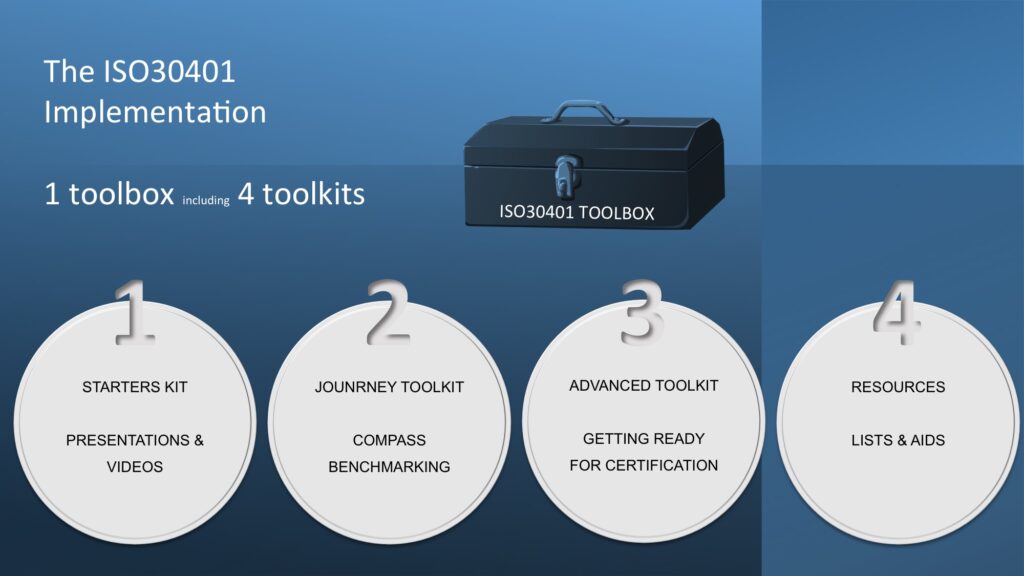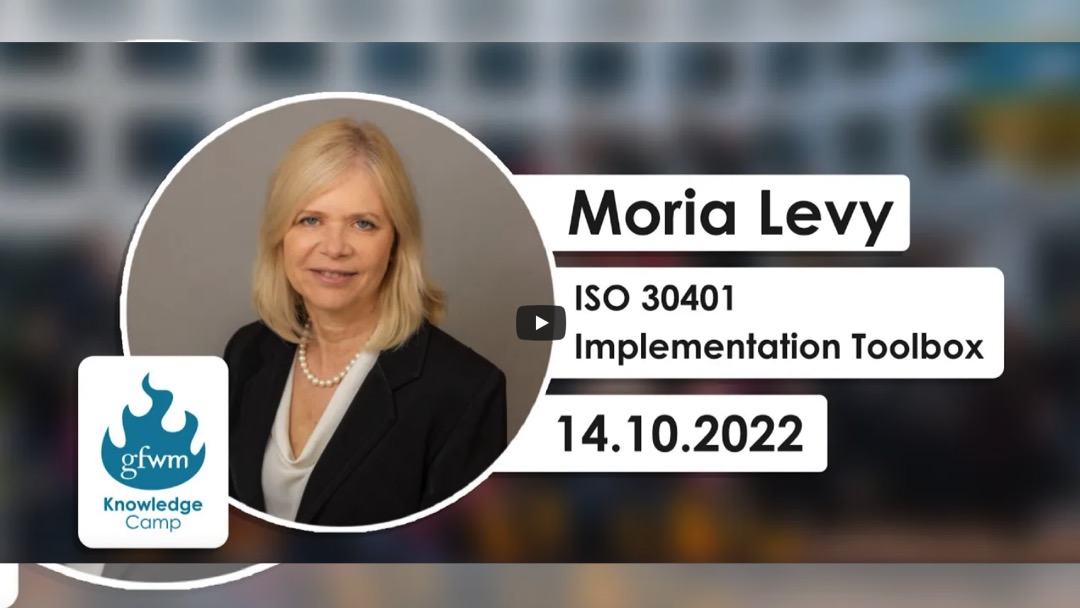Boosting the implementation of ISO30401
A collaborative community project.
Moria Levy (ROM Knowledgeware)
| Knowledge Management Essentials • Das Kuratierte Dossier, Band 5 • März 2023 Alle Beiträge • Kontakt Redaktionsteam |

Preface- the Knowledge Management discipline development
When I teach KMers, the history of the knowledge management discipline, in a university class, I pack it all in one lesson. KM is such a new discipline, and the main milestones can be counted probably using the fingers of one person (no toes required). Some will even argue that one hand will do: Coining the term of the knowledge worker (Peter Drucker, Landmarks of Tomorrow, 1959); The first well-known model explaining KM, or even more specifically, knowledge creation: the SECI model (Ikujiro Nonaka and Hirotaka Takeuchi, The Knowledge-Creating Company: How Japanese Companies Create the Dynamics of Innovation, 1995); The first (agreed) practical book explaining how to implement KM in organizations (Larry Prusak and Thomas Davenport, Working Knowledge, 1998). Somewhere before the term knowledge management was coined. But what more? And what after?
Many years have passed. Knowledge Management as a discipline developed; however, we didn’t experience any milestones. Thought leaders argued about definitions and principles. KM enlarged from mainly handling documents and communities of practice to a rich arsenal of solutions focused on organizational business needs, but no milestones were detected.
And then came 2018. After years of finding Australian and British unsuccessful attempts to define an agreed ISO-based guide, the word spread: ISO released a management standard defining KM requirements. Indeed, this was a revolution. The standard resulted from about twenty KM and ISO experts from many different places around the world sitting and discussing together for over two years, paragraph after paragraph, sentence after sentence, and word after word. Again and again. And again. A significant portion of the debates was resolved. It took some time, and most of those who tried to object (how can knowledge be managed? why should we agree to what a set of people suggest?) turned out to be a minority. Looking at thought leaders, books, and organizations, it seems we have a maturing discipline. We even agree on some ideas about what is essential and what KM excellence is.
One may think this was an ending; however, the central part has just begun.
KMGN – The Knowledge Management Global Network
Meantime, sometime in 2014, somewhere in East Asia, some KMers from different countries asked themselves how they could collaborate on their KM thinking. They established KMGN, the Knowledge Management Global Network. They started meeting and working together, slowly but systematically adding friends and colleagues from other countries and networks. In 2019 the objectives enlarged: Not only should we perform better KM in our organizations and societies. We have a mission. Networks representing 12 countries are already a community and have a responsibility. We can and must influence the KM discipline. We can give our share of bringing prosperity to the world through better KM in organizations and society. To succeed with such a sublime vision, KMGN had to carry several actions:
(a) To act, work, and be positioned as the most collaborative KM network. A network that does not earn such a degree of collaboration will find it challenging to develop the KM discipline significantly.
(b) To add as many KM networks as possible to KMGN. Adding networks enables the spread of new ideas and realizing the desired influence.
(c) To start working together as a community, developing the KM disciplines in areas where such is missing.
ISO30401 implementation was one of the projects fulfilling the latter.
The ISO30401 implementation project
The ISO30401 project was initiated to answer a KM need. From all over the world, we started hearing colleagues feeling uncomfortable with the slow level of ISO30401 implementation. It was natural. Management standards take much work to implement. If there are not enough organizations that implement it, it cannot turn out to be an actual mandatory requirement of customers when choosing their suppliers. If there are not enough certified organizations, it will not turn out to be a trend, and no pressure will be set to convince more organizations to aim for certification. The slower new organizations joined the respectful club of those with certification, the more challenging it was to add more. No one even had a list of who and how many organizations were certified.
Management standards define a high level of execution; hence, wide adoption of ISO30401 can serve as a movement to improve the level of knowledge management in organizations. Several thought leaders, starting in Pakistan, came up with the idea that what one cannot do alone, i.e., pushing the standard implementation forward, should be performed collaboratively. We understood that KMGN is fit to be the right platform, and such an initiative aligns with the KMGN vision and serves it.

The ISO30401implementation infrastructure
The ISO30401 infrastructure, now open and free to use, is a toolbox including four toolkits:
(a) Starters toolkit
A set of 11 video clips, and their accompanying presentations, explaining, step by step, what the ISO30401 is, what its requirements are, and why are the introduction and annexes, which do not include any requirement, essential for every KMer. This toolkit aims to introduce and mediate the language of ISO to KMers, easing the process of reading and understanding the standard.
(b) Compass toolkit
A toolkit including:
- a brief explaining the content of this toolkit and how to use it
- a detailed questionnaire that organizations are requested to answer
- a tool helping all organizations evaluate and grade themselves in the questionnaire above in an objective way, comparable to all others using this tool
- a radar on which every organization can place itself, learning what are the dimensions that should be addressed as part of the KM workplan
- a work plan template for short, medium, and long-term activities.
This toolkit aims to help organizations learn where to invest to excel, enabling them to benchmark themselves to other organizations.
(c) Advance toolkit
A toolkit that enables organizations with an advanced KM program, to translate their existing objectives, plans, and activities to the ISO language.
The tool kit comprises a brief (instructions on how to use it) and a set of templates that can be used.
This toolkit aims to help organizations with excellent KM win the certification efficiently and effectively, with minimal effort.
(d) A resources toolkit
A set of lists, videos, and documents that can supplement the process.
ISO30401 implementation – what next?
So now that we have a standard, and an implementation toolbox, what next?
Well, again, we are at an end. An end that is a beginning to a third stage: Actual implementation of the ISO30401 implementation in organizations, based on the infrastructure prepared.
Spoiler: This third additional stage is probably the “last” end. No more steps will be needed after. Just to enjoy the outcomes of prosperity due to excellent knowledge management programs in organizations.
We are all waiting for that day.
Moria Levy, Ph.D., serves as CEO and owner of ROM Knowledgeware, a leading KM solutions firm (40 employees). Levy is the chairman of the global expert committee of ISO30401 (Knowledge Management). Levy served as the 2022 chair of KMGN and leads the KMGN committee for “designing the future of KM”. Levy initiated KM studies, which are taught in high schools in Israel as part of the Ministry of Education of Israel‘s official digital knowledge and information program. Levy has published several books in the discipline of KM. Levy is known as an active researcher of KM. She has over 1,000 citations of her research publications and was recognized as a KM “classic research”, indexed by Thomson Reuters „Journal Impact Factor“ as her achievements. Levy is the chairman of the Israeli KM Forum.
About this contribution Text: Moria Levy · Editorial Team: Andreas Matern, Stefan Zillich · Images – key visual: Simon A. Eugster, CC BY-SA 3.0, https://creativecommons.org/licenses/by-sa/3.0/deed.de; figure: author of the contribution · Editorial Design: Stefan Zillich, re:Quest Berlin · published in: Das Kuratierte Dossier, vol. 5 “Knowledge Management Essentials”, March 2023, ISSN (Online) 2940-1380 · Published by Gesellschaft für Wissensmanagement e. V. · order print edition · About the series “Das Kuratierte Dossier” · © authors / GfWM e. V. 2023 · Imprint: Creative Commons Attribution NoDerivatives 4.0 International (BY-ND)
| Knowledge Management Essentials • Das Kuratierte Dossier, Band 5 • März 2023 Alle Beiträge • Kontakt Redaktionsteam |

